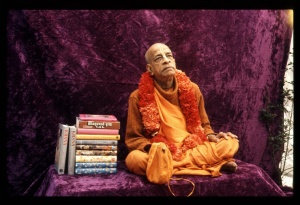CC Antya 1.138: Difference between revisions
m (1 revision(s)) |
No edit summary |
||
| Line 1: | Line 1: | ||
{{ | [[Category:Sri Caitanya-caritamrta - Antya-lila Chapter 01|C138]] | ||
<div style="float:left">'''[[Sri Caitanya-caritamrta|Śrī Caitanya-caritāmṛta]] - [[CC Antya|Antya-līlā]] - [[CC Antya 1|Chapter 1: Śrīla Rūpa Gosvāmī's Second Meeting With the Lord]]'''</div> | |||
<div style="float:right">[[File:Go-previous.png|link=CC Antya 1.137|Antya-līlā 1.137]] '''[[CC Antya 1.137|Antya-līlā 1.137]] - [[CC Antya 1.139|Antya-līlā 1.139]]''' [[File:Go-next.png|link=CC Antya 1.139|Antya-līlā 1.139]]</div> | |||
{{CompareVersions|CC|Antya 1.138|CC 1975|CC 1996}} | |||
{{RandomImage}} | |||
==== TEXT 138 ==== | ==== TEXT 138 ==== | ||
<div class="verse"> | |||
<div | :bhaktānām udagād anargala-dhiyāṁ vargo nisargojjvalaḥ | ||
bhaktānām udagād anargala-dhiyāṁ vargo nisargojjvalaḥ | :śīlaiḥ pallavitaḥ sa ballava-vadhū-bandhoḥ prabandho ‘py asau | ||
śīlaiḥ pallavitaḥ sa ballava-vadhū-bandhoḥ prabandho ‘py asau | :lebhe catvaratāṁ ca tāṇḍava-vidher vṛndāṭavī-garbha-bhūr | ||
lebhe catvaratāṁ ca tāṇḍava-vidher vṛndāṭavī-garbha-bhūr | :manye mad-vidha-puṇya-maṇḍala-parīpāko ‘yam unmīlati | ||
manye mad-vidha-puṇya-maṇḍala-parīpāko ‘yam unmīlati | |||
</div> | </div> | ||
| Line 15: | Line 18: | ||
==== SYNONYMS ==== | ==== SYNONYMS ==== | ||
<div class="synonyms"> | |||
<div | ''bhaktānām''—of devotees; ''udagāt''—has appeared; ''anargala-dhiyām''—constantly thinking of Rādhā-Kṛṣṇa; ''vargaḥ''—the assembly; ''nisarga-ujjvalaḥ''—naturally very advanced; ''śīlaiḥ''—with natural poetic decorations; ''pallavitaḥ''—spread like the leaves of a tree; ''saḥ''—that; ''ballava-vadhū-bandhoḥ''—of the friend of the ''gopīs''', Śrī Kṛṣṇa; ''prabandhaḥ''—a literary composition; ''api''—even; ''asau''—that; ''lebhe''—has achieved; ''catvaratām''—the quality of a quadrangular place with level ground; ''ca''—and; ''tāṇḍava-vidheḥ''—for dancing; ''vṛndā-aṭavī''—of the forest of Vṛndāvana; ''garbha-bhūḥ''—the inner grounds; ''manye''—I consider; ''mat-vidha''—of persons like me; ''puṇya-maṇḍala''—of groups of pious activities; ''parīpākaḥ''—the full development; ''ayam''—this; ''unmīlati''—appears. | ||
</div> | </div> | ||
| Line 23: | Line 25: | ||
==== TRANSLATION ==== | ==== TRANSLATION ==== | ||
<div class="translation"> | |||
<div | " 'The devotees now present are constantly thinking of the Supreme Lord and are therefore highly advanced. This work named Vidagdha-mādhava depicts the characteristic pastimes of Lord Kṛṣṇa with decorations of poetic ornaments. And the inner grounds of the forest of Vṛndāvana provide a suitable platform for the dancing of Kṛṣṇa with the gopīs. Therefore I think that the pious activities of persons like us, who have tried to advance in devotional service, have now attained maturity.' | ||
</div> | </div> | ||
==== PURPORT ==== | ==== PURPORT ==== | ||
<div class="purport"> | |||
This is verse 8 of the First Act of the ''Vidagdha-mādhava''. | |||
</div> | |||
<div | <div style="float:right; clear:both;">[[File:Go-previous.png|link=CC Antya 1.137|Antya-līlā 1.137]] '''[[CC Antya 1.137|Antya-līlā 1.137]] - [[CC Antya 1.139|Antya-līlā 1.139]]''' [[File:Go-next.png|link=CC Antya 1.139|Antya-līlā 1.139]]</div> | ||
__NOTOC__ | |||
</div> | __NOEDITSECTION__ | ||
__NOTOC__ | |||
Revision as of 11:35, 11 September 2021

A.C. Bhaktivedanta Swami Prabhupada
TEXT 138
- bhaktānām udagād anargala-dhiyāṁ vargo nisargojjvalaḥ
- śīlaiḥ pallavitaḥ sa ballava-vadhū-bandhoḥ prabandho ‘py asau
- lebhe catvaratāṁ ca tāṇḍava-vidher vṛndāṭavī-garbha-bhūr
- manye mad-vidha-puṇya-maṇḍala-parīpāko ‘yam unmīlati
SYNONYMS
bhaktānām—of devotees; udagāt—has appeared; anargala-dhiyām—constantly thinking of Rādhā-Kṛṣṇa; vargaḥ—the assembly; nisarga-ujjvalaḥ—naturally very advanced; śīlaiḥ—with natural poetic decorations; pallavitaḥ—spread like the leaves of a tree; saḥ—that; ballava-vadhū-bandhoḥ—of the friend of the gopīs', Śrī Kṛṣṇa; prabandhaḥ—a literary composition; api—even; asau—that; lebhe—has achieved; catvaratām—the quality of a quadrangular place with level ground; ca—and; tāṇḍava-vidheḥ—for dancing; vṛndā-aṭavī—of the forest of Vṛndāvana; garbha-bhūḥ—the inner grounds; manye—I consider; mat-vidha—of persons like me; puṇya-maṇḍala—of groups of pious activities; parīpākaḥ—the full development; ayam—this; unmīlati—appears.
TRANSLATION
" 'The devotees now present are constantly thinking of the Supreme Lord and are therefore highly advanced. This work named Vidagdha-mādhava depicts the characteristic pastimes of Lord Kṛṣṇa with decorations of poetic ornaments. And the inner grounds of the forest of Vṛndāvana provide a suitable platform for the dancing of Kṛṣṇa with the gopīs. Therefore I think that the pious activities of persons like us, who have tried to advance in devotional service, have now attained maturity.'
PURPORT
This is verse 8 of the First Act of the Vidagdha-mādhava.